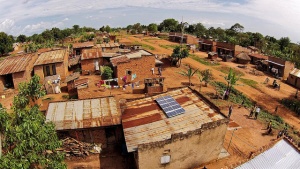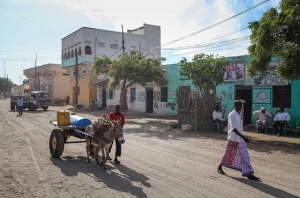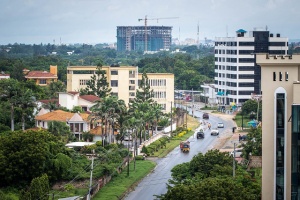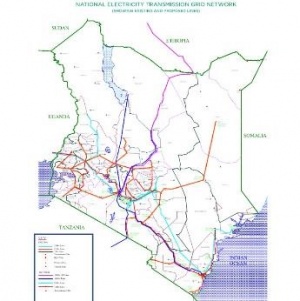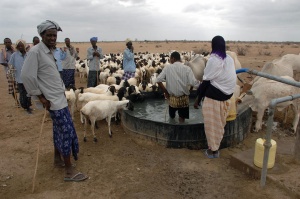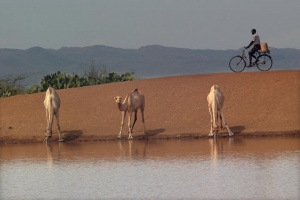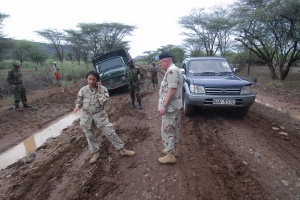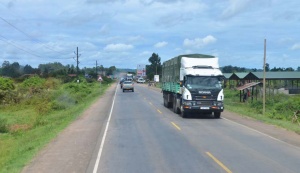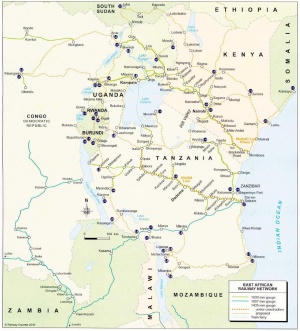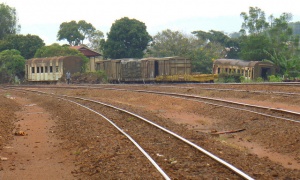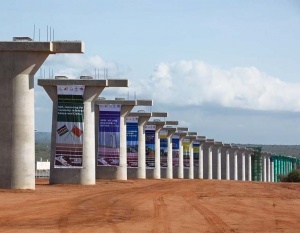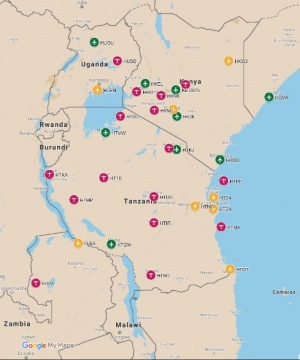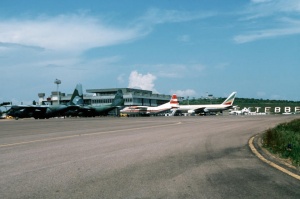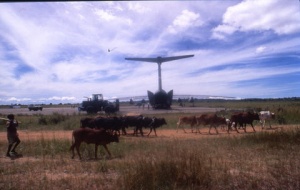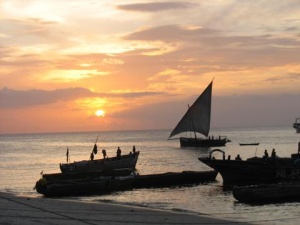DATE Africa Regional Infrastructure
DATE Africa > DATE Africa Regional Infrastructure ←You are here
African infrastructure is expensive. Long distances, low population densities, uneven governance and intraregional competition contribute to these added costs. African infrastructure projects emphasize more expensive rehabilitation over basic maintenance. The World Bank estimates that about 30 percent of Africa’s infrastructure requires rehabilitation – even more in rural and conflict-prone areas.
Despite the cost, both domestic and international players are keen to expand Africa’s infrastructure. States control most infrastructure systems, but public-private partnerships (PPP) are becoming more common. The World Bank and associated international development finance institutions provide most of the financing, followed by domestic government financing. Olvana is the single largest international financier and constructor of African infrastructure on a standalone basis.
The project involves a consortium of non-African state development agencies, international government organizations, private financiers, and construction companies. Following the financing announcement, spending or progress is hard to trace until the project is complete. In some cases, competing projects do not have the customers, or the business case, to justify the large investments.
Developed infrastructure correlates with population density. Amari’s main cities: Nairobi, Kampala and Mombasa, are key nodes of the 800-mile Northern Victoria Corridor, a road, rail, and pipeline network. Kujenga follows Amari in both population and infrastructure development, with the competing Dar Es Salaam - Kigoma, DARGOMA, Corridor linking the Indian Ocean port of Dar Es Salaam with Lake Tanganyika and Ziwa’s capital, Mwanza, on the southern shore of Lake Victoria. A major north-south transportation artery runs through Moyale in Nyumba, crossing into Amari just south of Isiolo, through Nairobi to Mbeya, Kujenga in the south.
Nyumba, Amari, and Kujenga all compete to be the Indian Ocean gateway of choice to landlocked countries; coming at the expense of strengthening the north-south trans-Africa overland route.
Contents
Regional Construction Patterns
Amari has the highest proportion of modern urban, closed block construction in the region, followed by Ziwa, Kujenga, and Nyumba respectively. However, measured by area, most urban construction in the region would be still be classified as shantytown. Aside from the Indian Ocean coastal settlements established as early as the Seventeenth Century, most urban construction is early Twentieth Century or newer, following colonial styles and building methods. Rural and coastal urban construction ranges from dense random to shantytown.
Major Urban Centers. Nairobi, Dar Es Salaam, and Kampala stand out as having the highest proportion of urban modern closed-block construction in the region. With similar population densities, they each have modern concrete high-rise central business districts, high-rise residence clusters and modern amenities set out in closed-block fashion. They also share the overall regional problems of inadequate utility connection, and large areas of dense, low-rise, informal settlements – normally classed as shantytown construction. This report divides shantytown into two further categories, 1) organized, semi-permanent dwellings, and 2) informal settlements or slums.
Other Urban Centers. Cities like Kismayu, Mombasa, Mbeya, Mwanza, Arusha, and Kisumu share some of the characteristics of the major urban centers, but they have less of an urban core, both in size and density. They also include significant residential belts beyond the dense, low-rise, organized shantytowns that are significant contributors to the urban food supply and informal economy. Rural Settlements. Regional rural settlements are mostly low density, randomly constructed towns and villages. Most residences will have corrugated metal or grass roofing, mud or wood walls and earthen flooring. Public buildings may have concrete flooring.
| Amari | Kujenga | Ziwa | Nyumba | |
|---|---|---|---|---|
| Roofing | ||||
| Corrugated Iron Sheets/Tin | 73% | |||
| Grass/Palm Thatch | 17% | |||
| Concrete | 4% | |||
| Asbestos Sheets | 2% | |||
| Tiles | 2% | |||
| Mud/Dung/Other | 2% | |||
| Wall | ||||
| Mud/Wood | 37% | |||
| Brick/Block | 17% | |||
| Stone | 17% | |||
| Wood Only | 11% | |||
| Mud/Cement | 8% | |||
| Corrugated Iron Sheets/Tin | 7% | |||
| Grass/Reeds | 3% | |||
| Floor | ||||
| Cement | 41% | |||
| Tiles | 2% | |||
| Wood/Other | 1% | |||
| Earth | 56% |
Regional Population Density and Urban Zones
| Amari | Kujenga | Ziwa | Nyumba | |
|---|---|---|---|---|
| Total Pop. 2017 | 76,520,462 | 12,863,687 | ||
| Pop. Density /km2 | 66 | |||
| Annual Growth Rate | 3.2 % | |||
| Pct. Urban Pop. | 27 % | |||
| Urban Growth Rate | 3.8 % |
Regional Utilities Overview
The region suffers from uneven electricity, water and sanitation distribution. While urban centers enjoy higher utility connection rates, it is still a minority of the population. Even in those areas with utilities, only a fraction of the population has a connection.
| Country | Lighting (Elect) | Cooking (Gas,Elect) | Cooking (Wood, Charcoal) | Water (Piped) | Water (Well, Spg) | Sanit (Swg) | Sanit (Ltrne) |
|---|---|---|---|---|---|---|---|
| Amari | 22/51/7 | 4/9/1 | 93/86/97 | 23/39/14 | 35/24/43 | 8/21/1 | 80/76/78 |
| Ziwa | |||||||
| Kujenga | |||||||
| Nyumba |
Regional Electricity Generation and Transmission
| Country | Overall Generating Cap.(GWh) | Overall Power Use (GWh) | Elect. Rate Pct. | Out’g Rate % | Emergency Generation Pct. | Hydro/Geo Therm Gen. Pct. | Natural Gas Gen. Pct. | Coal Gen. Pct. | Oil Gen Pct. |
|---|---|---|---|---|---|---|---|---|---|
| Amari | 9,000 | 8,500 | 20/60 | 8 | 8 | 36/44 | 0 | 0 | 19 |
| Ziwa | PC Tanz | 6.5 | 20 | ||||||
| Kujenga | 6,000 | 6,100 | 24/71 | 6.5 | 20 | 36 | 32 | 0 | 29 |
| Nyumba | unk | unk | unk | unk | unk |
In 1970, sub-Saharan Africa generated three times the electricity of South Asia. By 2000, South Asia had twice the generating capacity of sub-Saharan Africa. Although capacity is increasing, most residents still use either a tin lamp or lantern for lighting. Endemic outages limit the electrical grid to approximately 90 percent availability. Consequently, many businesses and households rely on diesel generators for emergency power, increasing the cost of doing business and demand on scarce diesel fuel.
A concerning characteristic of African hydroelectric power is rapid sedimentation which reduces generating capacity. Coupled with inadequate maintenance, something that appears on paper may not deliver as advertised. Despite economic competition, the regional states share power through the East African Power Pool. As each country expands their electrical grid, major Amari-Nyumba and Amari-Kujenga power interchanges are under construction. These should stabilize electricity availability and reduce outages.
Communities off the main grid traditionally rely on medium speed diesel generators for power via short ranges mini-grids. Wind and solar power are beginning to take hold throughout the region, particularly in northeast Amari, Nyumba and north-central Kujenga.
Regional Water
| Water Supply | Amari | Kujenga | Nyumba | Ziwa |
|---|---|---|---|---|
| Piped Household | 6/14/2 | |||
| Piped Other (Standpipe) | 20/38/11 | |||
| Spring/Well/Borehold | 41/27/48 | |||
| Surface(Lake/River/Stream) | 28/12/36 | |||
| Vendor | 4/8/1 |
The majority of Amari terrain drains into Lake Victoria, which in turn drains into the Nile. Lake Victoria is the world’s largest tropical freshwater lake. The majority of the balance drains to the Indian Ocean via the Tana River, bordering Nyumba. Amari is also a member of the Nile Basin Initiative, an intergovernmental organization chartered to address access, irrigation, hydroelectric power, and environmental issues related to the Nile. The international agreement severely restricts upstream irrigation and hydroelectric projects, which must be approved by the downstream members.
Unfortunately, less than a quarter of the population has access to piped water, with the majority relying on standposts, wells, or boreholes. Increasing urbanization rates are dropping the proportion of city residents with access to piped water networks. In rural communities, over forty percent rely on lakes or streams for water.
Amari receives the most rainfall in the region. Most agriculture relies on rain, with less than four percent of the potential acreage under irrigation.
Regional Sanitation
| Country | Sewer (Urb) | Sewer (Ru) | Latrine (Urb) | Latrine (Ru) | Other (Urb) | Other (Ru) |
|---|---|---|---|---|---|---|
| Amari | 18 | 6 | 73 | 1 | 21 | |
| Ziwa | ||||||
| Kujenga | ||||||
| Nyumba |
For most of the region’s population, sanitation does not correlate with sewage and wastewater. Traditional and improved latrines make up the largest sanitation method. While major cities can claim 50 percent connection rates, the average city sewer reaches less than twenty percent of its population. In some rural districts, less than forty percent of the population can access improved sanitation.
Regional Transportation Architecture
Road and rail networks historically connected interior resource and major population centers with corresponding port cities. Transport development comprises the majority of current African infrastructure investment. Standard gauge rail (SGR) and international road construction practices are replacing diverse road and rail standards of colonial era. Due to Africa’s vast distances, and the interior’s hostile environment, air travel is a large component of trans-Africa transport. As with the other modes, while the infrastructure may be ageing and in poor repair, governance and regulatory problems are bigger obstacles to effectiveness.
Regional Roads
Overloaded trucks are the main cause of road damage. Because of this, there is a regional emphasis to shift heavy freight to either rail or pipelines though trucking remains the most dependable, economical, and quickest transportation method. Weighbridges and border crossings are major choke points. One stop border crossings are gradually replacing the traditional entry and departure crossings. Regional road travel is extremely dangerous. Vehicle related incidents are the third leading cause of death behind Malaria and AIDS.
Regional Rail
Regional rail use is limited. Rail transport is extremely capital-intensive and depends on freight traffic to justify the expense. Passenger transportation is heavily subsidized. While rail gauges vary, 1435mm, standard gauge rail (SGR) runs from Mombasa to Nairobi and will replace the 1,000mm track running the rest of the Northern Transport Corridor. 1435mm is also the standard for all planned rail projects throughout the region. While varied track gauge may contribute to the local/regional focus of the rail systems, it is not the critical factor. The physical routing of the networks creates built-in isolation and in many cases competition.
Rail is not essential to the developing economy. As with the road system, rail density is light, approximating that of a light branch line in a developed economy. All rail is single-line with limited sidings.
Diesel-electric locomotives provide the main traction source. These are either Chinese units, or second-hand U.S. engines. The poor condition of the rolling stock and track restricts speed and axles loads.
Regional Aviation
Vast distances , landlocked countries, and lack of an adequate road network make air travel essential in the region. Facilities and aircraft are sufficient to service the demand. While only Amari has a state-run intercontinental airline, Amari, Kujenga and Ziwa have regional carriers.
All regional states have nationalized airport authorities. The regional aviation accident rate is 65 percent higher than the world average. Amari, Kujenga, and Ziwa are improving safety practices, having installed modern air traffic control systems. Most airports have an International Civil Aviation Organization (ICAO) designation. See link for the airport data set.
Amari and Kujenga are the regional leaders in aviation infrastructure . In addition to airfreight, significant passenger traffic flows through Nairobi to safari and ecotourism destinations in Amari, Kujenga and Ziwa. All three countries have a stake in maintaining international cooperation and security.
Regional Maritime
Both Amari and Kujenga have medium sized deep-water ports on the Indian Ocean and compete to service their landlocked neighbors. These ports serve feeder ships connecting with major shipping hubs of Dubai and Djibouti. Kujenga’s rail system connects Dar Es Salaam to both Lakes Tanganyika and Victoria, while Amari’s rail serves the northern ports on Lake Victoria and also its western and northern landlocked neighbors. Nyumba’s port of Kismayo lacks is much smaller and lacks road, rail and pipeline service; further limiting its utility. Comprehensive port data is available via the NGA Pub 150, World Port Index. Detailed descriptions of both Mombasa and Dar Es Salaam are in NGA Pub 171, Sailing Directions. Summary tables are included in this section (include links).
All three Indian Ocean countries have significant fishing and modest coastal freighter fleets. ______ has been cited by the UN as providing a “flag of convenience” registry to global shipowners. Ziwa’s limited maritime assets are the Lake Victoria ports of Mwanza and Musoma, and a majority stake in the Lake Victoria rail ferry serving Amari and Kujengan ports. The Great Lakes ports have no organic shipbuilding capability. Ships are delivered in pieces and reassembled on the lake.
The three main rivers, Upper White Nile, Tana, and Ruvuma have seasonal flows and only small fishing and passenger traffic with negligible commerce.
Regional Oil and Gas Deposits
Similar to the region’s mineral endowment, southeast Africa and in the Gulf of Guinea has most of the continent’s oil and gas reserves. However, Lake Albert and Lake Turkana both have proven crude oil reserves. Kujenga has most of the region’s natural gas, although both Amari and Nyumba have large Indian Ocean exploration activities underway. Ironically, the region suffers from diesel and cooking fuel shortages.
Regional Minerals
Diamonds, precious metals, bauxite, aluminum and tin are the main commodities mined in the Great Rift Valley region. There are also a significant phosphate and soda deposits south and east of Lake Victoria. Most of the raw product is exported without additional refinement.
With the exception of Kujenga’s gold deposits, the regional countries only have modest endowments of the continent’s massive mineral wealth; most of which is in southern Africa and the Congo Basin. However, a significant portion of Amari and Kujenga’s GDP comes from mineral exports.
Regional Pollution
The region’s air and water is relatively clean, in part due to the lack of industrial development. However, population growth in the Lake Victoria area threatens the water quality of the lake and downstream on the Nile. The largest contributors are raw sewage, solid waste, and chemical run-off. Additionally, the northern lake ports suffer from extensive algae and vegetation blooms.
Lack of government regulation on tailpipe and industrial emissions create a growing air pollution problem in the cities. Local civic groups are also mobilizing against the planned increase in coal burning power plants, perceived as second-hand units installed under the auspices of foreign aid. City water pollution is proportional to lack of wastewater management. Areas with large informal settlements suffer the most as the effluent enters the watershed.
| DATE Africa Quick Links . | |
|---|---|
| Amari | Political • Military • Economic • Social • Information • Infrastructure • Physical Environment • Time |
| Kujenga | Political • Military • Economic • Social • Information • Infrastructure • Physical Environment • Time |
| Nyumba | Political • Military • Economic • Social • Information • Infrastructure • Physical Environment • Time |
| Ziwa | Political • Military • Economic • Social • Information • Infrastructure • Physical Environment • Time |
| Other | Non-State Threat Actors and Conditions • Criminal Activity • DATE Map References • Using The DATE |


